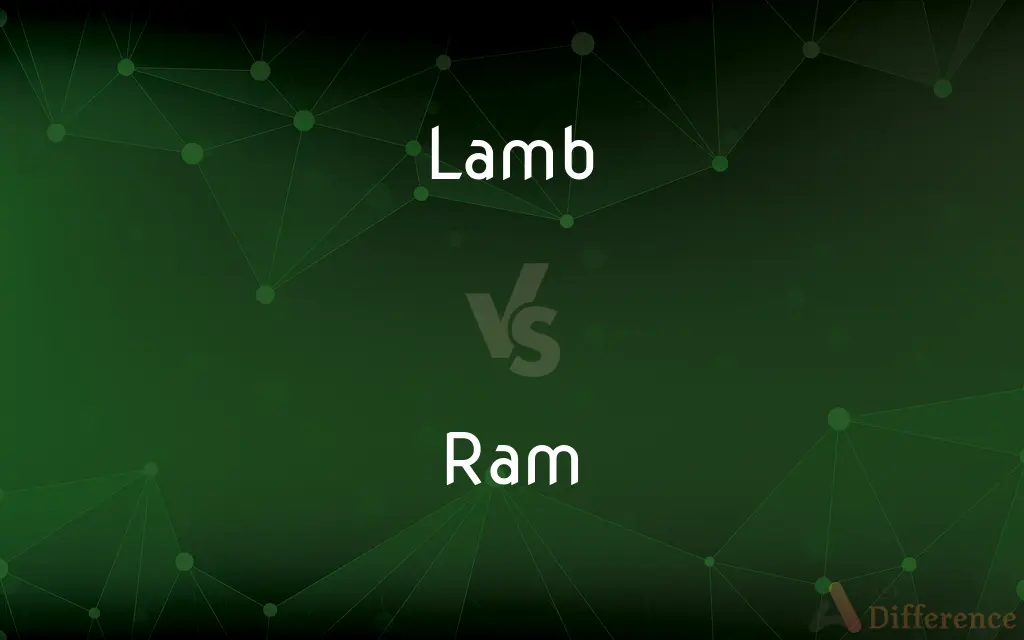Lamb vs. Ram — What's the Difference?
By Fiza Rafique & Maham Liaqat — Updated on March 4, 2024
Lamb refers to young sheep under one year, valued for tender meat, while a ram is an male sheep, known for breeding and wool production.

Difference Between Lamb and Ram
Table of Contents
ADVERTISEMENT
Key Differences
Lambs are young sheep typically under one year of age, known for their tender meat, which is a delicacy in many cuisines around the world. They represent the early life stage of sheep and are often associated with springtime and renewal. On the other hand, a ram is a male sheep, distinguished by its larger size, thicker wool, and often a set of curved horns. Rams play a crucial role in sheep breeding, contributing to the genetic diversity and quality of sheep herds.
While lambs are primarily raised for their meat due to its soft texture and mild flavor, rams are valued for their breeding capabilities and wool production. The wool from rams is generally coarser than that of lambs but is still an important resource for the textile industry. Additionally, rams can serve as flock leaders, providing structure and hierarchy within the herd.
Lambs are playful, curious, and more dependent on their mothers for protection and nutrition. This youthful behavior contrasts with the more assertive and dominant nature of rams, which often exhibit territorial behavior and can be aggressive during the breeding season. Rams are also responsible for protecting the flock from threats in many instances.
Lamb meat is considered leaner and more tender, with a distinctive flavor that varies less with the animal's age. Ram meat, on the other hand, is less commonly consumed and can have a stronger, more gamey taste, especially as the ram ages. The preference for lamb or ram meat can vary significantly across different cultures and cuisines.
Lambs require more attentive care, including feeding, vaccinations, and protection from predators and environmental elements. Rams, being more robust and independent, require different management focused on ensuring their health for breeding purposes and maintaining the quality of their wool.
ADVERTISEMENT
Comparison Chart
Age
Under 1 year old
Male sheep
Primary Use
Meat production
Breeding and wool production
Physical Characteristics
Smaller, more delicate features
Larger size, often with curved horns
Behavior
Playful, dependent
Assertive, dominant, protective
Nutritional Value
Leaner, tender meat with a mild flavor
Coarser wool, meat can be gamey
Husbandry
Requires attentive care and nutrition
Requires management for breeding and wool
Meat Preference
Preferred for its tenderness and flavor
Less commonly consumed due to strong taste
Role in Flock
Raised for meat and early life production
Provides genetic diversity, leadership
Compare with Definitions
Lamb
A young sheep under one year, prized for its tender meat.
The chef prepared a roast lamb for the holiday feast.
Ram
Rams have distinct curved horns and thick wool.
The farm's ram displayed impressive horns.
Lamb
Requires special care for growth and health.
The farmer vaccinated the lambs to ensure their wellbeing.
Ram
A male sheep, known for its breeding role.
The ram was chosen for its excellent wool and health.
Lamb
Lamb meat is a delicacy in various cuisines.
The menu featured grilled lamb as a special entree.
Ram
Key to genetic diversity in sheep herds.
Introducing a new ram improved the flock's quality.
Lamb
Symbolizes spring and renewal in many cultures.
Seeing lambs in the field signifies the start of spring.
Ram
Ram meat has a stronger flavor, less favored in some cuisines.
Ram stew is a traditional dish in some regions.
Lamb
Lamb's wool is soft and valuable for fine textiles.
The lamb’s wool was used to make a luxurious sweater.
Ram
Dominant and protective within the flock.
The ram often leads the flock and guards against predators.
Lamb
A young sheep.
Ram
An uncastrated male sheep.
Lamb
A young sheep, especially one that is not yet weaned.
Ram
A battering ram.
Lamb
To bring forth a lamb or lambs, as sheep.
Lamb
Give birth to a lamb;
The ewe lambed
Common Curiosities
What differentiates lamb from ram in terms of use?
Lambs are raised primarily for their meat, while rams are valued for breeding and wool.
How does the behavior of lambs compare to that of rams?
Lambs are playful and dependent, while rams are more assertive, dominant, and can be protective.
Can both lambs and rams produce wool?
Yes, but ram wool is generally coarser than lamb's wool, which is softer and more valuable for textiles.
What roles do rams play in a sheep flock?
Rams serve as breeders, contribute to genetic diversity, and often act as flock leaders.
What is the significance of a ram's horns?
Rams' horns are a distinctive physical trait that can indicate the animal's age and health.
How do rams affect the genetic diversity of sheep herds?
By breeding, rams introduce new genetic material, improving the herd's overall quality and resilience.
Why is lamb meat preferred over ram meat?
Lamb meat is tender and has a milder flavor compared to the stronger taste of ram meat.
How do lambs and rams contribute to the textile industry?
Lambs provide soft wool for fine textiles, whereas rams contribute coarser wool for other uses.
How is the meat of older rams perceived in culinary terms?
Older ram meat is considered to have a gamey taste and is less commonly consumed than lamb.
What management practices differ between lambs and rams?
Lambs require more attentive care for growth, while rams need management for breeding and wool quality.
What is the life expectancy of a lamb compared to a ram?
While lambs are young sheep under a year, rams can live several years, depending on their health and living conditions.
Why are lambs associated with springtime?
Lambs are often born in the spring, symbolizing renewal and new life in many cultures.
Why might farmers prefer to raise lambs over rams?
Farmers may prefer lambs for their meat production value, while rams are kept selectively for breeding and wool.
What nutritional differences exist between lamb and ram meat?
Lamb meat is leaner and more tender, making it more desirable for its nutritional and culinary properties.
Is there a cultural significance to eating lamb or ram meat?
Yes, lamb is widely consumed during various religious and cultural celebrations, while ram meat is specific to certain regional cuisines.
Share Your Discovery

Previous Comparison
Sociopath vs. Psychopath
Next Comparison
Armor vs. ArmourAuthor Spotlight
Written by
Fiza RafiqueFiza Rafique is a skilled content writer at AskDifference.com, where she meticulously refines and enhances written pieces. Drawing from her vast editorial expertise, Fiza ensures clarity, accuracy, and precision in every article. Passionate about language, she continually seeks to elevate the quality of content for readers worldwide.
Co-written by
Maham Liaqat













































